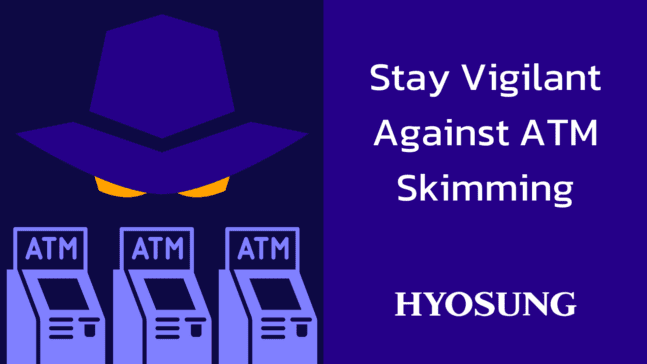
Bill Budde is the Vice President of Banking Strategy and Solutions for Hyosung. In this role, he helps banks and credit unions make decisions about branch transformation technology and unlock the value of those investments. Prior to joining Hyosung, Bill worked at JPMorgan Chase in both the Retail Banking and Merchant Processing business units, developing and implementing many self-service capabilities.
Today’s financial environment puts pressure on companies in all industries to reduce expenses. This pressure makes operational efficiency a key driver in investment decision-making for all companies, including financial institutions. Banks and credit unions of all sizes are looking for ways to operate more efficiently and reduce or eliminate non-value-added tasks. This has placed a focus on ATM recycling technology, with its ability to dramatically reduce cash servicing costs. The technology has reached a level of maturity in the US, providing an accessible path to leaner cash management.
The Basics: What Is ATM Recycling?
A traditional full-function ATM has two separate internal mechanisms that handle cash – one that dispenses cash for withdrawal transactions, and one that takes in and validates cash for deposit transactions. These two separate mechanisms operate independently, and they each require regular servicing to re-fill or empty them respectively.
ATM recycling involves using a single mechanism in an ATM that can both dispense cash and take in deposited cash. This recycling mechanism enables the ATM to take deposited cash, validate it, sort it, and store it by denomination. The ATM can then use that deposited cash for future customer withdrawals, reducing cash replenishment costs and activities.
ATM recycling has been around for decades, with over 800,000 such ATMs deployed worldwide, or 25% of the worldwide total. ATM recycling is still fairly new in the US, however, with only about 20,000 of the country’s 400,000 total ATMs, or approximately 5%, using the technology.
The Driver: How Does Recycling Deliver Value?
Cash recycling at the ATM offers many opportunities to increase efficiency and optimize costs. A significant portion of the value proposition for recycling ATMs comes from the fact that they require fewer cash replenishment and deposit pickup visits than traditional ATMs. One of the largest costs associated with managing ATMs is supplying cash for withdrawals and processing deposited cash – about 40% of the cost of operating an ATM is cash related. A meaningful reduction in such a large budget line item will have a significant impact on a bank’s bottom line.
At a recycling ATM, rather than deposited cash filling a bin in the ATM that then must be manually emptied and processed, customers are using their deposits to replenish the ATM with each transaction. Reducing the number of times an ATM requires cash service leads to a significant reduction in overall ATM expenses – sometimes by as much as 50% of cash servicing activity.
The value of recycling is not limited to reducing the amount of time spent on cash servicing events, however. Refilling an ATM is just the last step in a cycle of events to process, sort, count, and move cash through multiple stops before ultimately being placed inside an ATM. Each one of those counts also comes with a reconciliation process to ensure that step’s count equaled the previous step’s count, complete with exception processes for when those counts don’t match. As replenishment events are reduced, all steps in the cash cycle are reduced, driving a reduction in time and effort spent on branch cash operations and cash inventory management that has a noticeable effect on a financial institution’s bottom line.
Another significant advantage for recycling ATMs is increased ATM availability. As cash replenishment events are reduced, the downtime associated with those events is also reduced, increasing availability to customers during what are generally busy times of the day. Additionally, one of the largest categories of ATM service calls is replenishment errors – for example, cash straps left on bills or cassettes not seated correctly. Replenishment-induced issues can account for up to 20% of ATM repair calls. Fewer replenishment events will lead to fewer replenishment induced errors, and eliminates the down time associated with those errors.
Accessibility: Recycling Has Gone Mainstream
While Hyosung introduced core ATM recycling technology to the US over a decade ago, ATMs can’t just start recycling on their own. Many parts of the ATM environment require updates to fully support recycling, including transaction processing, cash management, and ATM monitoring. Some of the largest US banks have built this functionality internally, and have done the work to upgrade their environments to take advantage of recycling technology. Most financial institutions rely on third parties to supply these functions, however, and the companies offering these functions in the US haven’t typically operated under the “build it and they will come” philosophy of Field of Dreams, which has slowed widespread adoption. However, the recent spike in both interest and (perhaps more importantly) demand for this efficiency-driving functionality from financial institutions of all sizes has spurred many providers to act, making ATM recycling much more accessible. An investment is still required by a financial institution to update its ATM fleet to be capable of recycling, but many of the barriers that prevented full realization of recycling benefits have been removed, creating a clear path for that investment to yield strong results. Banks and credit unions across the country are now taking advantage of the opportunity to modernize their fleets and lower overall operating costs.
If you are ready to begin charting a course toward recycling at your ATMs, or if you have some questions on how this all works and want some more details, please contact your Hyosung sales representative or certified dealer, or you can contact us directly. We would love to help you find the right solution for your needs and help you navigate the path to achieving the operational efficiencies generated by recycling at the ATM.


